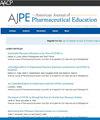LGBTQIA+医疗保健中的药学教育:教育策略和障碍的范围审查。
IF 3.8
4区 教育学
Q1 EDUCATION, SCIENTIFIC DISCIPLINES
引用次数: 0
摘要
目的:绘制和描述LGBTQIA+医疗保健药学教育的培训和教育策略,并确定面临的障碍。方法:到2023年12月,在PubMed、Scopus、LILACS和谷歌Scholar中进行综合检索。包括评价学生或药剂师在LGBTQIA+健康主题方面的药学教育的出版物。两位作者独立进行了研究选择和数据提取。结果:共纳入26项研究,主要集中在跨性别者(n = 14),并在美国(n = 19)进行了近7年的研究(n = 23)。大多数是横断面调查(n = 14),以药学专业学生为调查对象(n = 14)。LGBTQIA+医疗保健的教育策略主要包括讲座(n = 7)、基于临床病例的学习(n = 6)和LGBTQIA+个体的小组讨论(n = 4)。高级策略如角色扮演和OSCE仅用于药学学生(n = 4)。确定的障碍包括缺乏课程空间(n = 11)、与LGBTQIA+患者的接触最少(n = 6)、在正规教育和培训期间与受试者的接触有限(n = 6)、结论:本综述强调需要通过主动学习策略将LGBTQIA+健康主题纳入药学课程和继续教育,以培养高级能力。解决课程空间限制,增加对LGBTQIA+患者的接触,以及提高合格教育工作者的可用性,对于确保药剂师做好充分准备,为LGBTQIA+患者提供包容和有效的护理至关重要。本文章由计算机程序翻译,如有差异,请以英文原文为准。
Pharmaceutical Education in LGBTQIA+ Health Care: A Scoping Review of Educational Strategies and Barriers
Objective
To map and describe training and educational strategies and identify barriers faced in pharmaceutical education on lesbian, gay, bisexual, transgender, queer, intersex, asexual, and other identities (LGBTQIA+) health care.
Methods
A comprehensive search was performed in PubMed, Scopus, Latin American and Caribbean Health Sciences Literature, and Google Scholar until December 2023. Publications evaluating pharmaceutical education for students or pharmacists on LGBTQIA+ health topics were included. Two authors independently performed the study selection and data extraction.
Results
A total of 26 studies were included, mostly focusing on transgender individuals (n = 14) and conducted in the United States (n = 19) within the last 7 years (n = 23). The majority were cross-sectional (n = 14) and targeted pharmacy students (n = 14). Educational strategies in LGBTQIA+ health care included primarily lectures (n = 7), clinical case-based learning (n = 6), and panels with LGBTQIA+ individuals (n = 4). Advanced strategies like role-play and objective structured clinical examinations were used exclusively with pharmacy students (n = 4). Identified barriers included a lack of curriculum space (n = 11), minimal exposure to LGBTQIA+ patients (n = 6), limited contact with the subject during formal education and training (n = 6), and a shortage of qualified professionals to teach LGBTQIA+ topics (n = 5).
Conclusion
This review highlights the need to integrate LGBTQIA+ health topics into pharmacy curricula and continuing education through active learning strategies to develop advanced competencies. Addressing curriculum space limitations, increasing exposure to LGBTQIA+ patients, and enhancing the availability of qualified educators are essential to ensure pharmacists are well-prepared to provide inclusive and effective care to LGBTQIA+ individuals.
求助全文
通过发布文献求助,成功后即可免费获取论文全文。
去求助
来源期刊
CiteScore
4.30
自引率
15.20%
发文量
114
期刊介绍:
The Journal accepts unsolicited manuscripts that have not been published and are not under consideration for publication elsewhere. The Journal only considers material related to pharmaceutical education for publication. Authors must prepare manuscripts to conform to the Journal style (Author Instructions). All manuscripts are subject to peer review and approval by the editor prior to acceptance for publication. Reviewers are assigned by the editor with the advice of the editorial board as needed. Manuscripts are submitted and processed online (Submit a Manuscript) using Editorial Manager, an online manuscript tracking system that facilitates communication between the editorial office, editor, associate editors, reviewers, and authors.
After a manuscript is accepted, it is scheduled for publication in an upcoming issue of the Journal. All manuscripts are formatted and copyedited, and returned to the author for review and approval of the changes. Approximately 2 weeks prior to publication, the author receives an electronic proof of the article for final review and approval. Authors are not assessed page charges for publication.

 求助内容:
求助内容: 应助结果提醒方式:
应助结果提醒方式:


